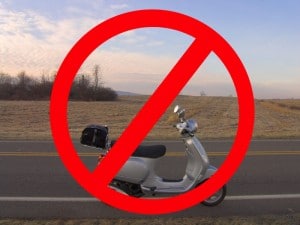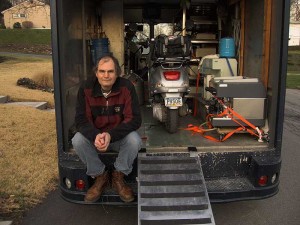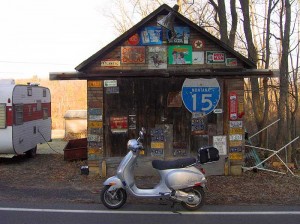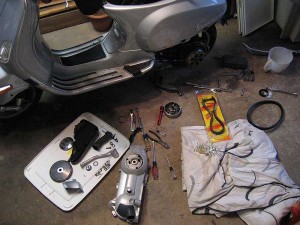The scooter has been in my garage since trucking it home last Friday evening. It will not start. I’ve worked hard to diagnose the problem and get it back on the road. And I’ve learned a few things–about the Vespa and myself.
I am not a mechanic nor particularly mechanically inclined. Turning wrenches doesn’t bring joy or satisfaction, particularly in a cold, messy, poorly lit garage. Making the decision to try and fix the scooter grew out of a desire to not feel helpless or vulnerable should the Vespa die on a trip. Like it did–last Friday.
I have the Piaggio Shop Manual for the LX150 and a Haynes manual too. The Modern Vespa forum is a great source of information and assistance, as well as my friend Paul. I assumed that the worse case would be to haul the broken scooter to our local Vespa dealer for repair.
My first lesson began at Modern Vespa. Searching posts on non-starting scooters eventually led me to post a request for help. Their Technical Moderator Gary, a motorcycle enthusiast and career engineer from New Jersey, took on the role of master with me the student. Troubleshooting a problem is not rote operation. At least not for me. Gary patiently instructed me on how the various components work together and generally demystified the mechanics of each step of diagnosis. His instruction allowed me to remain mostly free of fear, frustration and cursing. And witness the miracle of a functioning vacuum fuel tap and the free flow of petrol (thank you Mr. Charpentier) from the fuel line as I humbly sucked on the associated vacuum line.
My lessons were many but here are a few of the mechanical processes I now can engage:
1. Test functioning of vacuum fuel tap
2. Remove and install sparkplug
3. Test to verify functioning of starter relay
4. Test for spark
5. Test cylinder compression
6. Remove carburetor, remove fuel bowl and verify free flow of fuel through primary and main jets
7. Test high voltage coil
8. Test for spark while plug is in cylinder and firing under compression using an induction timing light
9. Assessment of battery voltage and grounding
Gary was extremely patient, available and able to provide expert information and instruction. I don’t expect to any time soon be doing the Darth Vadar thing indicating I was once the student but now the master. Maybe in another life. Thank you Gary!
I worked on the scooter a little at a time over five evenings. Some other things I’ve learned is Kim is not turned on by a man wearing the engine, oil and petrol fragrance. And she is actively opposed to starting ether wafting through the house. Paul also helped me with moral support and to manufacture a crude scooter compression gauge from one designed for those big sparkplug holes of an automobile. Thanks Paul!
Riding experience has reached into the garage. The patience learned on the road was accessible during these mechanical lessons. I was able to pay attention and as thoughtfully as my skills would allow work on the scooter. And when things didn’t go right or the thing still wouldn’t start I would just move on to the next test.
I would like to announce here “The scooter starts and it is back on the road!” Sadly that is not the case. I have exhausted all things I can test and everything is pointing to a faulty CDI box. This is the electronic box that control ignition. Can’t be tested, just needs swapped out and hope that solves the problem. I’m comfortable that I’ve exhausted all the things I can do and will haul the scooter to the dealer for this expensive bit of work. Bad luck on my part that none of the more common failures were in play.
Should you attempt this work on a scooter or motorcycle? Depends on you, depends on the scooter or bike. The Vespa is quite simple, doesn’t require a lot of expensive tools, and information is readily available. The key is yourself. Do you want to do this? For me it was a good experience and I will turn the wrench again. I definitely feel I could fix a lot more things in the field now than I did last Friday. So for now I am on a holiday from riding in the sticks.









